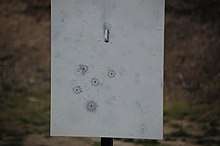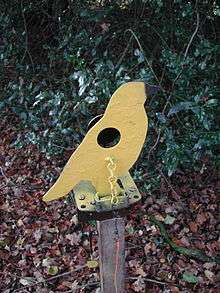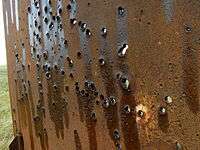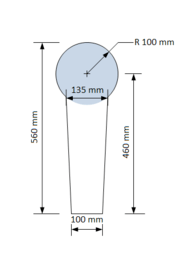Steel target


Steel targets are shooting targets for firearms made out of hardened (martensitic) steel, and are used in sports such as cowboy action shooting, practical/dynamic shooting and for long range shooting, as well as recreational plinking. They are popular in both training and competitions because the shooter gets instant feedback on a hit in the form of sound, and one can also often see the bullet getting pulverized and the target moving. Hanging or self-resetting targets also have the advantage that the shooter need not go forward to tape the targets, making it a good option for shooting ranges that otherwise have electronic targets. Steel targets also are weather proof, contrary to paper targets that do not hold up when wet.
Precautions regarding ricochets
If correct precautions are taken, the chance of ricochets when shooting at steel targets are minimal. The materials of which both the target and bullets are constructed should be chosen to cause the bullets to pulverize on impact, and therefore hardened steel targets and regular lead core bullets or copper jacketed bullets should be used. Unhardened steel should be avoided for use in targets, and ammunition with armor-piercing properties (i.e. steel cores) should also be avoided.
Furthermore, it is important always to shoot steel targets at an angle of 100 to 110 degrees relative to the target, with the angle specifically chosen such that the target is tipped slightly downwards 10-20 degrees off vertical so that any ricochet immediately strikes the ground. This angling of the target also minimizes distortion of the steel target, and prolongs the life of the steel target. Localized heating, causing loss of hardness, is also minimized by this proper choice of the angles when mounting steel targets. Steel targets must also not be solidly mounted, but must be mounted such that movement of the steel target can occur. This additionally reduces the loss of hardness, prolonging the life of the steel target.
It is important that shooters shoot only at steel targets that have stopped moving, such that the downward angle is safely available, to avoid ricochets. Blindly shooting at steel targets that are bouncing around is a recipe for disaster, with a strong possibility of unintended ricochets causing personal injury or damage to property.
Target material

As a safety precaution, steel targets must be made out of hardened steel, which is more resistant to plastic deformation than regular, soft steel. For steel targets, the steel should have a Brinell value of 500 or slightly more. One American producer of steel targets claims to use only steel with a hardness greater than 500, most often between 515-540. They also claim that the steel gets too brittle if higher Brinell values are used.[1] Hardened steel is available in different Brinell values or thicknesses, and stainless variants are also available. A common trademark in the United States for hardened steel is AR500.
Regular steel is too soft, resulting in bullets either punching through the target or making a crater whereupon subsequent bullets may bounce back toward the shooter or spectators, often with great force. Even thick plates quickly get holes and craters if they are made of regular steel (i.e. 10 mm or 3/8").
Processing of the steel target
Many workshops have the tools to manufacture steel targets out of hardened steel, but it is important that it be done correctly. For instance, water jet cutters or laser cutters are preferred, but plasma cutters can be used. In contrast, angle grinders or normal welding damages the hardening. Hardened drill bits are also needed to cut holes in hardened steel targets.
Thickness and distance to the target
The required thickness of the target depends on the distance intended for shooting, steel quality, caliber, bullet type, and bullet speed. High velocity rounds more easily penetrate steel targets, meaning that faster bullets even of relatively small calibers or diameter are more likely to punch through a target.
Manufacturers recommends at least 1/4" thickness (6.35 mm) with 500 Brinell value for pistol shooting with common calibres such as 9 mm, .40 S&W and .45 ACP, with a safety distance of 10 yards (approx. 10 m). For rifle shooting, manufacturers recommend at least 3/8" (9.525 mm) 500 Brinell steel, and different distances according to what caliber is used. For calibers like .223 and .308 at least 100 yards are required for long target life. For larger and faster calibers such as 22-250, 30-06, 300 Win Mag or .338 Lapua 200 yards or farther is recommended. Nevertheless, the targets can often been shot at from much closer without any problems, provided proper angles are maintained.[1]
Bullet choice
Lead core or frangible bullets are preferred, since they are pulverized upon high-velocity impact, and the dust will then be spread out to the sides of the target. However, bullets with hard cores (like steel, or "bi-metal") are not pulverized and can either penetrate or ricochet, causing them to be potentially dangerous. Since lead isn't magnetic, competition organizers may use a magnet to check for the presence of a ferromagnetic core. Copper jacketed bullets work fine with steel targets, provided that minimal distance guidelines are followed.
Fixing
Chains and shackles makes the most sound and is the most popular method for fixing hanging targets. Sections of old fire department hose is popular, for reasons of longevity. Ropes are quickly torn, but another alternative that lasts quite long are inner tubes of tires.[2]
Competition use
Practical shooting
In practical shooting, administered by IPSC, both cardboard and steel targets are used. Standardized steel targets, called "poppers", are often used, but other forms and shapes can be used as long as they comply with the rules. The smallest sizes for respectively circular and square targets, both for rifle and pistols, are 15 cm Ø/ 15x15 cm, while the largest targets allowed for pistols are 30 cm Ø/ 30x30 cm and for rifles 30 cm Ø/ 45x30 cm.
 IPSC Popper (formerly known as the Classic Popper).
IPSC Popper (formerly known as the Classic Popper). IPSC Mini Popper (formerly known as the Classic Mini Popper).
IPSC Mini Popper (formerly known as the Classic Mini Popper). Pepper Popper, now obsolete.
Pepper Popper, now obsolete. Mini Pepper Popper, now obsolete.
Mini Pepper Popper, now obsolete.
See also
References
- 1 2 Shooters Element Archived 2014-05-20 at the Wayback Machine.
- ↑ Handgun Sports